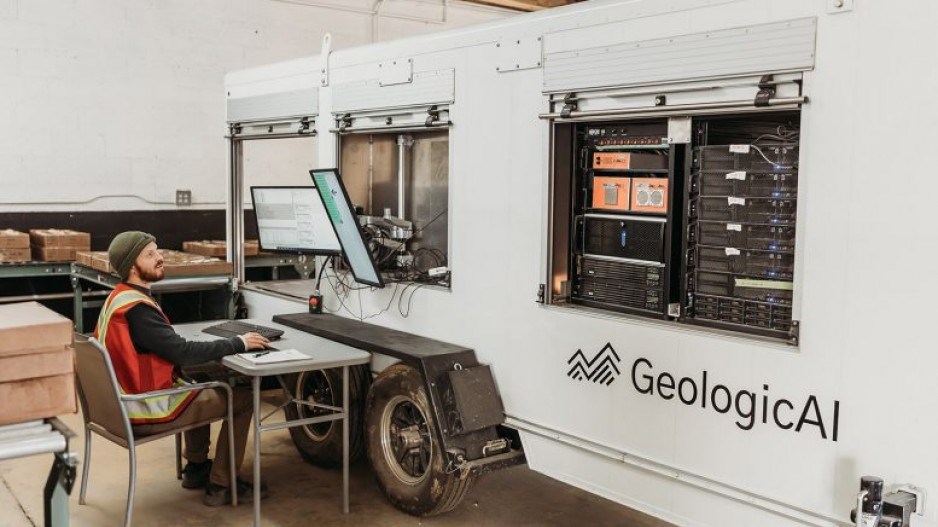GeologicAI, a Canadian tech company with Vancouver-based Agnico Eagle Mines (TSX: AEM; NYSE: AEM) as a client and the backing of the Bill Gates-funded Breakthrough Energy Ventures, is part of a rising trend of services using artificial intelligence (AI) to boost discoveries.
The Calgary company scans core samples under five types of sensors and uses AI to crunch and correlate the data right on site. So far, it’s operating in Canada, the United States, Australia, Bolivia and Finland. All the equipment is contained in a trailer towed by truck or lifted by helicopter to a mining project. GeologicAI provides operators and has about 18 trailers.
“Precision information matters,” CEO and co-founder Grant Sanden said in emailed comments. “We have the capability of taking geologic data from ‘I have something,’ to ‘I have exactly this.’”
AI burst into wider awareness with last year’s release of ChatGPT and involves machines learning from experience. The mining industry wants to improve on the traditional visual core inspections that can benefit from more data and analysis. Two-thirds of mining companies are already using AI, according to The Oregon Group, an investment research publisher.
Much of the industry’s AI helps manage vehicle fleets and production facilities where it has improved milling efficiencies by 10-20%, supply ordering by as much as 50% and cut greenhouse gas output by 15-30%, the researcher said. But AI has also figured in some prominent discoveries.
New Found Gold (TSXV: NFG; NYSE-AM: NFGC) used AI technology from GoldSpot Discoveries, now part of Brisbane-based ALS, in the 2019 drill hole that started the central Newfoundland gold surge. Hole NFGC-19-01 returned 19 metres grading 92.9 grams gold per tonne and 6 metres of 285.2 grams gold from 96 metres downhole at the Queensway project just west of Gander.
Oil and gas start
Sanden and fellow University of Calgary engineering student Yannai Segal formed their company as Enersoft a decade ago to serve the oil and gas industry. They pivoted into mining in 2021 and changed the name to GeologicAI. Breakthrough Energy Ventures, a Seattle-based venture capital company founded by Microsoft’s Gates, invested US$20 million into GeologicAI in June.
The company’s trailers run five key sensors on cores: hyperspectral, x-ray diffraction (XRF), red-green-blue photography (RGB), light detection and ranging (Lidar) and magnetic susceptibility.
They help detect minerals, compositions and ratios that may not be visible to the naked eye by stitching together the different sensor data.
Samples are placed on a table controlled by a robot that moves them through the sensors. It takes about 15-20 minutes for one scan and the trailer handles 300 to 500 metres of core a day. They can run 24/7. The company also offers core logging services, able to log 300 metres in a 24-hour period.
Steve Gray, exploration manager at Agnico Eagle’s Detour Lake mine in northern Ontario, says Canada’s largest gold producer is using GeologicAI equipment to probe the underground potential next to the site’s open pit.
“Core scanning can help fill information gaps related to geological constraints, geometry and mineral continuity,” Gray said in a company video posted in July. “By collecting more qualitative and consistent interpretation of rock properties combined with improved insights from high-resolution data, core scanning assisted by AI will help to optimize regional targeting.”
Other clients include Toronto-based Eloro Resources (TSXV: ELO; US-OTC: ELRRF) with its Iska Iska silver-tin project in southern Bolivia, and Fireweed Metals (TSXV: FWZ; US-OTC: FWEDF), which has the world’s largest high-grade tungsten project, Mactung, and the Macmillan Pass lead-zinc-silver project in the Yukon.
Competitors
GeologicAI faces a rising number of competitors in the space, including Montreal-based Windfall Geotek, Sweden’s Minalyze, KORE GeoSystems and StratumAI of Toronto and the TrueScan unit of Salt Lake City-based Boart Longyear.
“They may just have RGB imagery that they’re pulling stuff off of or just straight up XRF and RGB or straight up hyperspectral and RGB,” GeologicAI marketing director Jessica Andrew said in a phone interview. “But where we come in and we’re different is we take all five of those sensors and we do it all.”
The Quebec-based Global Mining Guidelines Group has an industry working group on AI to spread understanding of the tool to optimize processes while also noting its risks.
“The transition to an AI-enabled mine will look different for every organization,” the group says on its website. “An inadequate, poorly prepared, or inefficient implementation can result in revenue loss, accidental system failures, resistance to change, potential hazards and labour risks.”
The technology may help companies cope with worker shortages in the industry after executives such as Rob McEwen noted this year there are fewer geology students in universities than in 1970. The new technology usually converts skeptics used to seasoned geologists with magnifying loops in hand, Andrew said.
“We’ve had several examples of people going ‘I don’t need that,’” Andrew said. “Once we convince them to just take a look, they immediately switch over and realize the value of this tool, that it’s actually making the job a lot easier and more efficient.”




